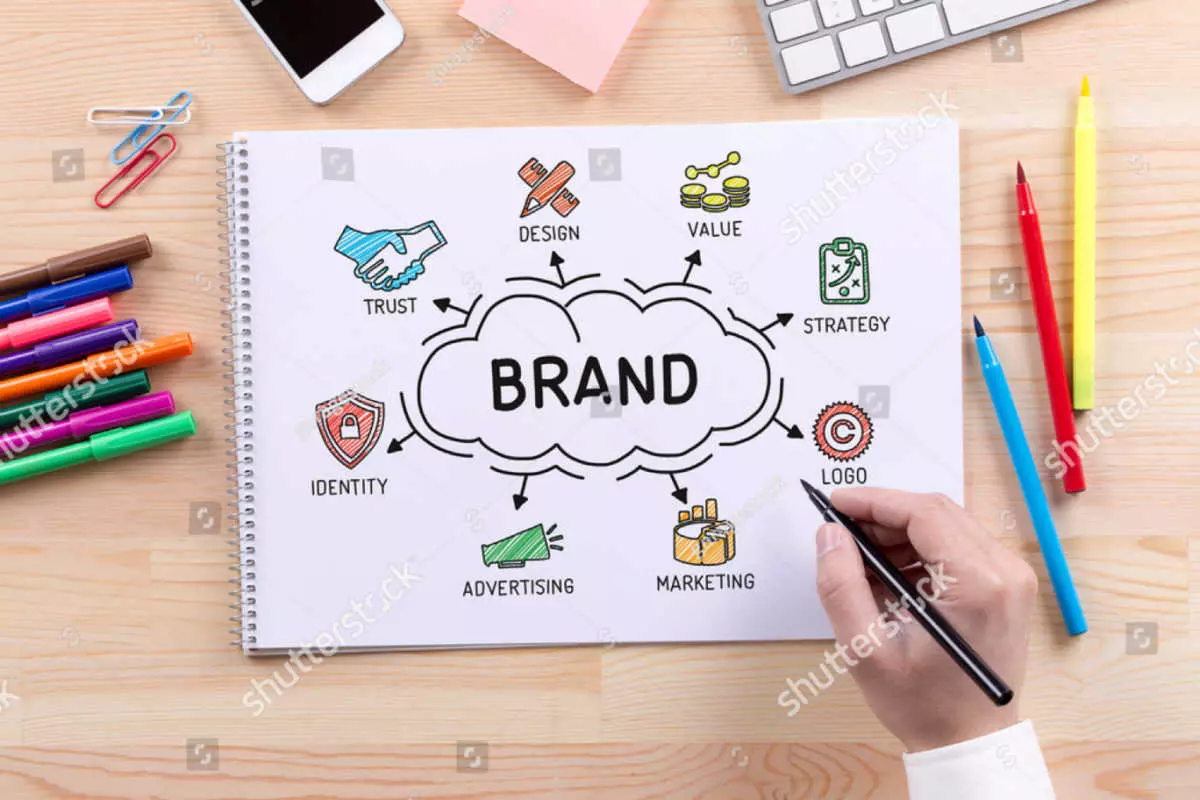Your brand is one of the most valuable assets for your company. It embodies what your company stands for and how your consumers, peers, and competition view you. Moreover, successful business branding increases a company’s customer base and creates trust and credibility. Consequently, successful branding develops a unique relationship between the consumers and the company, allowing the latter to capitalize on their loyalty and enjoy a competitive edge in the market against their competitors. With that being said, let’s find out how to brand your business.
What Is a Brand?
A brand is a marketing concept that helps people identify a particular company, product, or individual and distinguish it from its competitors in the market. Branding and marketing are used interchangeably, but branding has specific elements. A brand can help shape people’s perception of your company and identify it through its name, tagline, logo, colors, or other components.

Nike is a strong example of a good brand. The company is named after the Greek Winged Goddess of Victory – Nike. In addition, Nike’s “Swoosh” logo, which symbolizes the goddess’ wing, speed, movement, and power, alongside the tagline “Just Do It,” is immediately recognizable, even when viewed separately from any other marketing materials.
Define Your Brand Identity
Your brand identity is how you want to be viewed. It is the core of your brand and what you stand for. It includes your values, mission, vision, brand personality, and visual aesthetic. Your brand identity is communicated through every part of your company, including your logo, colors, and online and in-store experiences. The goal is to make your brand memorable and appealing to the consumer and set you apart from your competitors. Therefore, before you move forward with your business branding, take the time to clarify who you are as a company; in other words, define your brand identity.
For example, Coca-Cola was established in 1886 and is one of the world’s most recognizable brands. The brand’s signature bright red and white colors stood the test of time, especially when paired with its unique serif-script font to evoke a hand-drawn quality, making the brand feel approachable. In addition, the company capitalized on a unique opportunity to associate its brand with the holiday season with festive advertising campaigns featuring the image of the Coca-Cola Santa Claus by portraying him as a warm and happy character with rosy cheeks, a white beard, sparkling eyes, and laughter lines.
Consequently, the brand is often associated with happiness and the positive feeling associated with the holiday season. Nonetheless, Coca-Cola doesn’t base its brand identity solely on holiday cheer. Instead, the brand also promotes various other campaigns and slogans, such as “Share A Coke,” “Open Happiness,” and “Taste the Feeling.”
Create Your Brand Style
After defining your brand identity, the next step should include creating your brand style guide. The guide should help you figure out the details of your design strategy, such as your logo, story, color palettes, typography, iconography, photography, and graphics. Moreover, your brand style guide is necessary for your small business branding to be consistent and in check across all digital materials and future marketing campaigns.
Logo
Your logo is the first thing most customers will notice when they encounter your brand. It is the visual asset most closely tied to your business as it is one of the first things that may come to mind when thinking about a company.

In other words, it is the face of your company and will be seen everywhere your brand exists, such as on your website and social media pages. For example, your logo can be a mascot such as Wendy’s brand logo, an emblem such as Starbucks, or an abstract design such as Google Chrome.
Story
Your brand’s story can create an emotional connection and strengthen your relationship with your audience. The narrative must affect the consumer emotionally or psychologically to be impactful. Consequently, by resonating with the story, the customer may be more likely to recall or be aware of the brand. In addition, engaging in brand storytelling can open doors to expanding your target audience.
You can tell your story through various mediums such as videos to capture your targeted audience’s attention. No matter what medium you choose, ensure that you create high-value content to attract consumers more effectively to purchase your product or service.
For example, Home Depot is an excellent example of a brand that uses attraction marketing successfully. The home supply company offers free weekly classes and workshops to teach its audience how to use its equipment, offering free value to prospects without forcing them to purchase anything.
Color Palettes
Your color palettes play a significant role in branding your business and making an excellent first impression on your consumers. Colors don’t only define the look of your brand; they also convey a feeling. Therefore, your brand’s colors should reflect how you want to make your consumers feel when they encounter or think about your company, products, and services.
For example, red represents excitement, purple represents creativity, blue is associated with trust, green represents peace and health, yellow evokes optimism, and orange represents friendliness.
In addition, the right colors can distinguish your brand from competitors, attract customers, and create brand-based loyalty. For instance, using a signature color improved consumers’ brand recognition by 80%.
Typography
Unique fonts and typographic elements can help consumers easily identify your brand through logo designs. Specifically, typography can convey the brand’s voice, personality, and message through visual elements.

Typographic elements in business branding include font, size of the font, visual arrangement, color contrast, and space. For example, famous brands like Coca-Cola and Disney have created and registered their unique typography and made it part of their brand identity.
Iconography
Another element in business branding is iconography, which can help simplify and translate ideas effectively without using a single word. Every icon you use on your business’s website or marketing materials should share a similar style, structure, and color to contribute to a consistent brand experience that is unique to your company.
For instance, on an e-commerce website, you can encounter a shopping bag icon that symbolizes shopping, a trash bin icon to delete or remove an item, and a heart icon to save your favorite products.
Photography and Graphics
Photography and graphics are also important elements to brand your business and create your brand style. They are essential in promoting your company’s image through campaigns and visuals and making your business uniquely recognizable and positively viewed. Moreover, quality photos are essential for your website because studies show that 67% of consumers say they check the quality of a product image when deciding whether to purchase an item.
The Website
Now that you have defined your brand identity and created your brand style, it is time to share your brand online through your website. Most often, your website is the first interaction your customers have with your company. Therefore, branded images, logos, fonts, and colors should be integrated into the website design to promote consistency.

Lastly, consider leveraging ad tracking software to understand the performance of your ad campaigns and get insights into your audience’s interest and online buying behavior. Ad tracking is also helpful in understanding the ad designs that appeal to your customers and the channels generating the most leads.
Follow the Three Cs
When branding your business, always keep in mind the three Cs of branding: clarity, consistency, and commitment. Following the three Cs will help you succeed in your branding efforts.
Clarity
Take the time you need to clarify your brand identity. The more clarity you get on who you are and what you’re about the more you can infuse that identity into your branding. Customers don’t have to interpret your branding to figure out your message. Instead, your messages must be loud and clear and convey the company’s value, particularly how your brand can help clients, address their needs, and improve their lives. If your brand is unclear, it will evoke confusion which may lead your customers to buy from your competition.
Consistency
When it comes to branding your business, consistency is crucial across all platforms. The look, feel, and design of every part of your business must be consistent, from your website to social media channels and in-store consumer interactions. Consistency builds familiarity, trust, and loyalty. If you are not consistent with your brand identity, you risk confusing your consumers and losing them to the competition.
For example, in 1958, the Coca-Cola company reformulated its soft drink and launched New Coke to revitalize the brand and gain market share in the beverage industry. The new formula had a similar taste to its rival Pepsi, whose market shares were steadily growing. However, the Coca-Cola company had severely underestimated its consumers’ sentimental attachment to its brand and lost around $30 million. Moreover, by adjusting the flavor, the company attacked its value proposition and consistency. Nonetheless, the original formula returned to the market under Coca-Cola Classic, and the company saw its sales increase.
Commitment
You must commit to your company’s brand identity to succeed as an entrepreneur. Great branding takes time, and you shouldn’t get discouraged and shift directions. If you commit to your business and brand, your customers will also commit to you, which will increase your customer loyalty.
Develop a Tagline
A tagline, also called a slogan, is a memorable phrase that accompanies your brand name to encapsulate and convey your brand’s values in a few unique words. When developing your tagline, make sure it is short, memorable, original, and reflects your brand’s identity, character, promise, and personality.

Some famous slogans include Apple’s “Think Different,” L’Oréal Paris’ “Because You’re Worth It,” and McDonald’s “I’m Lovin’ It.”
Stay True to Your Brand
Staying true to your brand is fundamental once you have identified your brand identity, story, and the feelings and values you want to convey to your customers. Moreover, as your company grows and succeeds, maintain your brand identity and remain consistent across every level of your organization. If you constantly change your brand, you risk confusing customers as to what type of company you are in, which may have unfavorable consequences. Therefore, identify your values, maintain authenticity, and stay true to your brand.
Iterate and Refine
Staying true to your brand does not mean refusing to iterate and refine. Therefore, rebranding your business is possible because your brand identity can evolve. For example, iterating and refining are essential to keep up with emerging trends and consumer preferences in today’s digital world. Consequently, you can find new ways to improve your brand, products, or services and meet consumer needs. To do so, ask for feedback from your customers to learn more about their needs in a competitive market.
Lastly, conduct a brand audit at least once every year to evaluate your brand’s position in the marketplace. This will help you evaluate your brand’s position in the marketplace, gain insight into your strengths and weaknesses, understand how your customers perceive your brand, and uncover growth opportunities.
For example, in 2018, Dunkin Donuts successfully revealed its new brand identity and dropped the word “donuts” in a rebrand to modernize customers’ experience. Moreover, the brand got a new logo and freshened up its brand messaging, which resonated with its audience.
Sum-Up
It is a necessity to have a strong brand identity to stand out from the crowd. Your brand identity allows consumers to know, understand, relate to, and most importantly, stay loyal to you. Make sure your branding is clear and consistent and commit to it. Then, as your company grows and succeeds, iterate and refine your branding to stay relevant and satisfy the market’s growing needs.
Have a Question? Ask an Expert!
Fill out the form below to get in touch with one of our marketing specialists.
